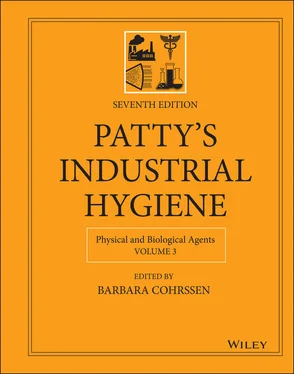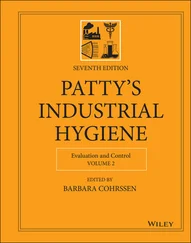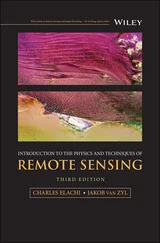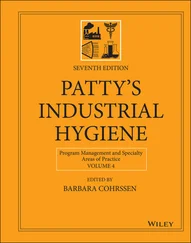Glassblowers often wear didymium glass lenses to filter out intense yellow light at about 590 nm emitted by sodium in molten glass. Didymium glass has high transmittance in much of the IR region, however, and should, therefore, be combined with additional IR and UV filtering (91). Cobalt blue lenses are effective at filtering yellow light, UV, and IR. Filter lenses with shade number no less than 2.5 are recommended for work with soda lime or quartz glass (91), and higher shades may be appropriate (90).
A guideline published by the American Foundry Society recommends shade numbers for eye protection during melting and pouring operations based on the metal being handled: iron (shade Nos. 3–5: green); steel (shade No. 8: green, or shade No. 6: cobalt blue); brass/bronze (shade Nos. 3–5: green, or shade No. 3: green with No. 3 aluminized face shield, or shade No. 6 cobalt blue half lenses); aluminum (clear, no‐tint) or magnesium (clear, no‐tint) (94).
1 1. International Agency for Research on Cancer (IARC) (1997). IARC Monographs on the Evaluation of Carcinogenic Risks to Humans, Vol. 55, Solar and Ultraviolet Radiation. Lyons: IARC.
2 2. Reidenbach, H.‐D., Dollinger, K., and Hofmann, J. (2005). Results from two research projects concerning aversion responses including the blink reflex. Proc SPIE 5688: 429–439.
3 3. Sliney, D.H., Bitran, M., and Murray, W. (2012). Infrared, visible and ultraviolet radiation. In: Patty's Toxicology, 6e, vol. 6 (ed. E. Bingham and B. Cohrssen), 169–209. New York: Wiley.
4 4. Suess, M.J. (1989). Introduction to the second edition. In: Nonionizing Radiation Protection (ed. M. Suess and D. Benwell‐Morison), 2–3. Copenhagen: World Health Organization Regional Office for Europe.
5 5. Diffey, B.L. (2002). Sources and measurement of ultraviolet radiation. Methods 28: 4–13.
6 6. Commission Internationale de l'Éclairage (CIE) (1999). Standardization of the Terms UV‐A1, UV‐A2 and UV‐B, 134/1 CIE TC 6‐26 Report. Vienna: CIE.
7 7. Hale, G. and Querry, M. (1973). Optical constants of water in the 200 nm to 200 μm wavelength region. Appl Opt 12: 555–563.
8 8. Sliney, D. and Wohlbarsht, M. (1980). Safety with Lasers and Other Optical Sources. New York: Plenum Press.
9 9. Wolfe, W.L. (1998). Introduction to Radiometry. Bellingham, Washington: SPIE Optical Engineering Press.
10 10. Ryer, A.D. (1997). The Light Measurement Handbook. Peabody, Massachusetts: International Light Technologies.
11 11. Seinfeld, J.H. and Pandis, S.N. (1998). Atmospheric Chemistry and Physics, 26–33. New York: Wiley.
12 12. Reader, J. and Corliss, C.H. (1998). Line spectra of the elements. In: CRC Handbook of Chemistry and Physics, 79e (ed. D.R. Lide), 10–43. Boca Raton: CRC Press.
13 13. Oriel Instruments (1999). The Book of Photon Tools, 1–44. Stratford, CT: Oriel Instruments.
14 14. American National Standards Institute/Illuminating Engineering Society of North America (ANSI/IESNA) (2005). Recommended Practice for Photobiological Safety for Lamps and Lamp Systems – General Requirements, (ANSI/IESNA RP‐27.1‐15), 13. New York: IESNA.
15 15. American Conference of Governmental Industrial Hygienists (ACGIH) (2018). 2018 Threshold Limit Values (TLV®) and Biological Exposure Indices (BEIs®), 159–164. Cincinnati, OH: ACGIH.
16 16. International Commission on Non‐Ionizing Radiation Protection (ICNIRP) (2004). Guidelines on limits of exposure to ultraviolet radiation of wavelengths between 180 nm and 400 nm (incoherent optical radiation). Health Phys 87: 171–186.
17 17. Commission Internationale de l'Éclairage (CIE) (1999). Erythema Reference Action Spectrum and Standard Erythema Dose, (ISO 17166; CIE S 007/E). Geneva: International Organization for Standardization (ISO).
18 18. Sliney, D.H. (2000). Ultraviolet radiation exposure criteria. Radiat Prot Dosimetry 91: 213–222.
19 19. International Commission on Non‐Ionizing Radiation Protection (ICNIRP) (2013). ICNIRP guidelines on limits of exposure to incoherent visible and infrared radiation. Health Phys 105: 74–96.
20 20. American Conference of Governmental Industrial Hygienists (ACGIH) (2018). Threshold Limit Values (TLV®) and Biological Exposure Indices (BEIs®), 150–158. Cincinnati, OH: ACGIH.
21 21. American National Standards Institute/Illuminating Engineering Society, (ANSI/IES) (2015). Recommended Practice for Photobiological Safety for Lamps and Lamp Systems – General Requirements, (ANSI/IES RP‐27.1‐15), 5–7. New York: Illuminating Engineering Society of North America.
22 22. Seckmeyer, G., Bais, A., Bernhard, G. et al. (2010). Instruments to Measure Solar Ultraviolet Radiation – Part 4: Array Spectroradiometers, (WMO/TD‐No. 1538). Geneva: World Meteorological Organization.
23 23. Seckmeyer, G., Bais, A., Bernhard, G. et al. (2008). Instruments to Measure Solar Ultraviolet Radiation – Part 2: Broadband Instruments Measuring Erythemally Weighted Solar Irradiance, (WMO TD‐No. 1289). Geneva: World Meteorological Organization.
24 24. Barlier‐Salsi, A. (2014). Stray light correction on array apectroradiometers for optical radiation risk assessment in the workplace. J Radiol Prot 34: 915–930.
25 25. Nevas, S., Wübbeler, G., Sperling, A. et al. (2012). Simultaneous correction of bandpass and stray‐light effects in array spectroradiometer data. Metrologia 49: S43–S47.
26 26. Egli, L., Gröbner, J., Hülsen, G. et al. (2016). Quality assessment of solar UV irradiance measured with array spectroradiometers. Atmos Meas Tech 9: 1553–1567.
27 27. Commission Internationale de l'Éclairage, (CIE) (2016). Characterization and Calibration Methods of UV Radiometers, (CIE 220:2016). Vienna: CIE.
28 28. Pye, S.D. and Martin, C.J. (2000). A study of the directional response of ultraviolet radiometers: I. practical evaluation and implications for ultraviolet measurement standards. Phys Med Biol 45: 2701–2712.
29 29. Pulli, T., Kärhä, P., and Ikonen, E. (2013). A method for optimizing the cosine response of solar UV diffusers. J Geophys Res Atmos 118: 7897–7904.
30 30. American National Standards Institute/Illuminating Engineering Society of North America, (ANSI/IESNA) (2010). Recommended Practice for Photobiological Safety for Lamps and Lamp Systems – Measurement Techniques, (ANSI/IES RP‐27.2‐00/R17), 7. New York: IESNA.
31 31. Heydenreich, J. and Wulf, H.C. (2019). Personal electronic UVR dosimeter measurements: specific and general uncertainties. Photochem Photobiol Sci doi: 10.1039/c8pp00379c.
32 32. Allen, M. and McKenzie, R. (2005). Enhanced UV exposure on a ski‐field compared with exposures at sea level. Photochem Photobiol Sci 4: 429–437.
33 33. Peters, C.E., Demers, P.A., Kalia, S. et al. (2016). Levels of occupational exposure to solar ultraviolet radiation in Vancouver, Canada. Ann Occup Hyg 60: 825–835.
34 34. Tenkate, T. and Collins, M. (1997). Personal ultraviolet radiation exposure of workers in a welding environment. Am Ind Hyg Assoc J 58: 33–38.
35 35. Wainwright, L., Parisi, A.V., and Downs, N. (2016). Dual calibrated dosimeter for simultaneous measurements of erythemal and vitamin D effective solar ultraviolet radiation. J Photochem Photobiol, B 157: 15–21.
36 36. Moehrle, M., Korn, M., and Garbe, C. (2000). Bacillus subtilis spore film dosimeters in personal dosimetry for occupational solar ultraviolet exposure. Int Arch Occup Environ Health 23: 575–580.
37 37. Serrano, M.‐A., Cañada, J., and Moreno, J.C. (2013). Solar UV exposure in construction workers in Valencia, Spain. J Expo Sci Env Epid 23: 525–530.
38 38. Shi, Y., Manco, M., Moyal, D. et al. (2018). Soft, stretchable, epidermal sensor with integrated electronics and photochemistry of measuring personal UV exposures. PLos ONE 13: doi: 10.1371/journal.pone.0190233.
Читать дальше












